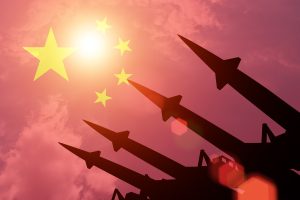Earlier this month, the Bulletin of Atomic Scientists published its annual assessment of China’s nuclear forces. The authors of the latest assessment state that China has gone through significant expansion and modernization of its nuclear forces as well as enhancing the size of its arsenal. Despite the relative lack of transparency involving China’s nuclear weapons program, which makes it difficult to quantify, the report said that it is “likely the fastest-growing arsenal in the world.”
Meanwhile, the New York Times reported in December 2023 that new evidence suggested China is possibly readying a military base in order “to test a new generation of nuclear weapons.” If it is the case, it could be unsettling for the region and the global non-proliferation order in many ways.
The authors of the “Chinese nuclear weapons, 2024” Bulletin report note that since the 2023 edition of the assessment, China has kept up with the work on its three new missile silo fields, focusing on solid-fuel intercontinental ballistic missiles (ICBMs). According to this report, China also appears to have “expanded the construction of new silos for its liquid-fuel DF-5 ICBMs” as well as “developing new variants of ICBMs and advanced strategic delivery systems, and has likely produced excess warheads for eventual upload onto these systems once they are deployed.” The authors also added that China has “further expanded its dual-capable DF-26 intermediate-range ballistic missile force, which appears to have completely replaced the medium-range DF-21 in the nuclear role.”
The efficacy of these systems is a different question entirely, particularly in light of reports on extensive corruption within the Chinese military, especially the People’s Liberation Army (PLA) Rocket Force. According to media reports, the U.S. assesses that there are “several examples of the impact of graft, including missiles filled with water instead of fuel and vast fields of missile silos in western China with lids that don’t function in a way that would allow the missiles to launch effectively.”
China has also enhanced the naval and air arms of its strategic forces. On the naval front, China is equipping its Type 094 ballistic missile submarines (SSBNs) with longer-range JL-3 submarine-launched ballistic missiles (SLBMs). The JL-3 SLBM, with an estimated range of more than 10,000 kilometers, is a “significant improvement” over the previous JL-2 missiles that had a range of about 8,000 km, and it can reportedly target the continental United States.
The Type 094 SSBNs are still considered to be “relatively noisy” as compared to the more advanced Type 096 SSBNs, which are yet to enter the service. The Type 096 SSBNs are expected to enter service in the late 2020s or early 2030s according to the Pentagon’s China Military Power Report (CMPR) of 2023. Type 096 SSBNs are believed to be more advanced, similar “to state-of-the-art Russian submarines in terms of stealth, sensors and weapons.” Considering that the lifespan of the SSBNs is around 30-40 years, it is expected that China will operate both the SSBNs for a bit of time. The CMPR of 2023 had also stated the China is already “fielding the longer-range JL-3 SLBMs” on its older Type 094 SSBNs.
Meanwhile, the latest Chinese nuclear weapons report says that Beijing is augmenting its strategic aerial capabilities, with a recent upgradation providing “an operational nuclear mission to its bombers” as well as “developing an air-launched ballistic missile that might have nuclear capability.”
On the size of the Chinese nuclear arsenal, the assessment is that China “has produced a stockpile of approximately 440 nuclear warheads for delivery by land-based ballistic missiles, sea-based ballistic missiles, and bombers” while an additional 60 warheads are “thought to have been produced, with more in production, to eventually arm additional road-mobile and silo-based missiles and bombers.” This is in line with the Pentagon’s 2023 CMPR estimates, which said that China “possessed more than 500 operational nuclear warheads as of May 2023.” The CMPR also said that the U.S. estimate is that China could possibly “have over 1,000 operational nuclear warheads by 2030, much of which will be deployed at higher readiness levels and will continue growing its force to 2035.”
The CMPR added that China “has loaded at least some ICBMs into these silos. This project and the expansion of China’s liquid-propellant silo force is meant to increase the peacetime readiness of its nuclear force by moving to a launch-on-warning (LOW) posture.” Construction of silos fits with the launch-on-warning capability that China is possibly developing because silos could provide much faster reaction time, which is necessary for LOW. In addition, China has also been enhancing its strategic intelligence gathering capabilities through satellite-based means as well as by collaborating with Russia. Along with the capability development for a launch on warning posture, China’s introduction of dual-purpose missiles presents unnecessary complications such as ambiguities in the minds of adversaries, which is a risky proposition.
With the current expansion-cum-modernization of China’s nuclear forces along with its delivery systems, Beijing’s stated decades-long policy of minimum deterrence with a small nuclear force to undertake a retaliatory second strike is increasingly open to question. This could trigger regional responses given the state of major power relations in the Indo-Pacific. China’s SSBN enhancements are pushing for deterrence measures like AUKUS, a trilateral arrangement among the United States, United Kingdom, and Australia but there could be many more such partnerships. In addition, countries in the region will possibly be stepping up their own national deterrence capabilities.
China’s engagement in arms control discussions, albeit quite limited, is a good step. The first such promising sign was the dialogue with the United States in November 2023. The expectation is that it could lead to Beijing appreciating the usefulness of dialogue and transparency, and hopefully leading to a pause in its nuclear expansion, at least in relative terms. If not halted, China’s nuclear expansion could lead to a spiraling arms race in terms of expanding nuclear arsenals.

































